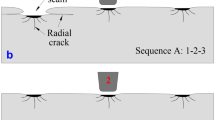Abstract
The cutting efficiency and wear of tunnel boring machine (TBM) cutters are two important parameters commonly used to estimate the boring performance and lifetime of the TBM in the tunneling process. These problems have been investigated by several researchers, whereas the influence of jointed rock mass and mixed ground condition on the cutting efficiency and cutter wear remains insufficiently understood. This study aims to elucidate the influence of rock mass and ground parameters on the cutting efficiency and cutter wear of the TBM by conducting a series of newly developed rolling boring tests on prefabricated joint sandstone samples with different orientations, spacings, and interlayers. Moreover, a numerical simulation is implemented through ANSYS software to verify the rationality of experimental results. The experimental and numerical results indicate that the optimal joint orientation is 30° for the TBM to intrude into a jointed rock mass. As joint spacing increases, the cutting efficiency decreases and the cutter wear increases. Furthermore, specific energy (SE) and cutter wear simultaneously reach their maximum values when the rock abrasivity index (RAI) is 60. Both the specific energy and cutter wear decrease with increasing specific strength. For the rock mass with a soft interlayer in mixed ground, the optimal dip angle is 45°. Additionally, the fitting formulas of SE and cutter wear in mixed ground are proposed to quantitatively illustrate the effect of RAI and interlayer strength on the cutting efficiency and cutter wear. The present study provides an improved understanding of rock-breaking mechanics, thereby making it possible for designers to adjust their design to enhance the TBM cutting efficiency.











Similar content being viewed by others
References
Bejari H, Hamidi KJ (2013) Simultaneous effects of joint spacing and orientation on TBM cutting efficiency in jointed rock masses. Rock Mech Rock Eng 46:897–907
Bruland A (1998) Hard rock tunnel boring. Ph.D. thesis, Norwegian University of Science and Technology
Choi SO, Lee SJ (2016) Numerical study to estimate the cutting power on a disc cutter in jointed rock mass. KSCE J Civ Eng 20(1):440–451
Exadaktylos G, Stavropoulou M, Xiroudakis G, Broissia MD, Schwarz H (2008) A spatial estimation model for continuous rock mass characterization from the specific energy of a TBM. Rock Mech Rock Eng 41:797–843
Gehring K (1995) Performance and cutter-wear prediction for tunnel boring machines. Felsbau 13(6):439–448
Gong QM, Jiao YY, Zhao J (2006) Numerical modelling of the effects of joint spacing on rock fragmentation by TBM cutters. Tunn Undergr Space Technol 21(1):46–55
Hassanpour J, Rostami J, Azali ST, Zhao J (2014) Introduction of an empirical TBM cutter wear prediction model for pyroclastic and mafic igneous rocks; a case history of Karaj water conveyance tunnel, Iran. Tunn Undergr Space Technol 43:222–231
Jeong HY, Cho JW, Jeon S, Rostami J (2016) Performance assessment of hard rock TBM and rock boreability using punch penetration test. Rock Mech Rock Eng 49:1517–1532
Johnson KL (2003) Contact mechanics. Cambridge University Press, Cambridge
Liu QS, Liu JP, Pan YC, Lei GF, Luo CY (2017) A Wear Rule and Cutter Life Prediction Model of a 20-in. TBM Cutter for Granite: A Case Study of a Water Conveyance Tunnel in China. Rock Mech Rock Eng 50:1303–1320
Ma HS, Yin LJ, Gong QM, W J (2015) TBM tunneling in mixed-face ground: Problems and solutions. Int J Min Sci Tech 25(4):641–647
Plinninger RJ (2010) Hardrock abrasivity investigation using the Rock Abrasivity Index (RAI). Taylor and Fancis Group, London, pp 3445–3452
Rostami J (1997) Development of a Force Estimation Model for Rock Fragmentation with Disc Cutters through Theoretical Modeling and Physical Measurement of Crushed Zone Pressure. Ph.D. thesis, Colorado School of Mines
Rostami J, Ozdemir L (1993) New model for performance production of hard rock TBMs. In: Rapid excavation and tunnelling conferences. Boston, USA, pp 793–809
Salimia A, Jamal R, Christian M, Andrea D (2016) Application of non-linear regression analysis and artificial intelligence algorithms for performance prediction of hard rock TBMs. Tunn Undergr Space Technol 58:236–246
Teale R (1965) The Concept of Specific Energy in Rock Drilling. Int J Rock Mech Min Sci Geomech Abstr 2(1):57–63
Toth A, Gong QM, Zhao J (2013) Case studies of TBM tunneling performance in rock-soil interface mixed ground. Tunn Undergr Space Technol 38:140–150
Vergara IM, Saroglou C (2017) Prediction of TBM performance in mixed-face ground conditions. Tunn Undergr Space Technol 69:116–124
Wang LH, Kang YL, Cai ZX, Zhang Q, Zhao Y, Zhao HF, Su PC (2012) The energy method to predict disc cutter wear extent for hard rock TBMs. Tunn Undergr Space Technol 28:183–191
Wang LH, Li HP, Zhao XJ, Zhang Q (2017) Development of a prediction model for the wear evolution of disc cutters on rock TBM cutterhead. Tunn Undergr Space Technol 67:147–157
Yang HQ, Wang H, Zhou XP (2016) Analysis on the damage behavior of mixed ground during TBM cutting process. Tunn Undergr Space Technol 57:55–65
Zhang Z, Meng L, Sun F, Chin J (2014) Wear analysis of disc cutters of full face rock tunnel boring machine. Chin J Mech Eng 27(6):1294–1300
Acknowledgements
This study is financially supported by Shenzhen Science and Technology Innovation Commission (Grant No. JCYJ20160531192824598), research fund of key laboratory of tunnel engineering, Southwestern Jiaotong University (TTE2014-04), the Natural Science Fund of China (Nos. 51879016), and the National Basic Research Program of China (973 Program, No. 2014CB046903).
Author information
Authors and Affiliations
Corresponding author
Additional information
Publisher’s Note
Springer Nature remains neutral with regard to jurisdictional claims in published maps and institutional affiliations.
Rights and permissions
About this article
Cite this article
Zhao, Y., Yang, H., Chen, Z. et al. Effects of Jointed Rock Mass and Mixed Ground Conditions on the Cutting Efficiency and Cutter Wear of Tunnel Boring Machine. Rock Mech Rock Eng 52, 1303–1313 (2019). https://doi.org/10.1007/s00603-018-1667-y
Received:
Accepted:
Published:
Issue Date:
DOI: https://doi.org/10.1007/s00603-018-1667-y




